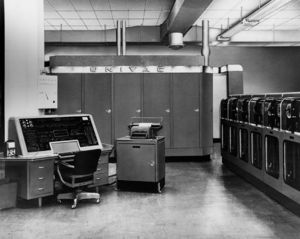UNIVAC

UNIVAC, the UNIVersal Automatic Computer, was the first computer built for general commercial use and used magnetic tape, rather than punch cards, to input and store data.
John Presper Eckert and John Mauchly began the development of the UNIVAC in April 1946. Eckert and Mauchly were part of a cadre of scientists and mathematicians who created computer systems for the United States during World War II. Their punch-card based Electronic and Numerical Integrator and Computer (ENIAC) helped the military improve the accuracy of their artillery fire.
After the war, Eckert and Mauchly sought to commercialize this technology, but their employer, the University of Pennsylvania, demurred. The university offered the duo tenure in exchange for their release of the patents on the ENIAC. They declined and left academia in 1946, starting a company that would become the Eckert-Mauchly Computer Corporation.
Eckert and Mauchly developed the UNIVAC during the next five years under contract with the United States Census Bureau. It sought a more efficient way of processing millions of pieces of data. A series of delays and cost overruns led to financial problems at the fledgling company, and in October 1949 the chairman of the company, Harry L. Straus, died in a plane crash. In 1950, Eckert and Mauchly’s company was sold to typewriter manufacturer Remington Rand, which had its own calculating machine division under the direction of former Manhattan Project Director Leslie Groves.
Operating within Remington Rand, Eckert and Mauchly’s group was able to complete the project and delivered the first UNIVAC to the Census Bureau on March 31, 1951. This achievement came despite Remington’s disinterest in the project—like their rivals at IBM, they remained staunch supporters of traditional punch-card technology—and hostility towards Mauchly, whom they believed to be a Communist sympathizer, and the female programmers, including Grace Hopper, who had led the project.
UNIVAC’s speed outshined all of its competitors—it was thousands of times faster than its rivals—but more importantly, it was among the first “stored program” computers, using magnetic tape, rather than punch cards, to collect and manage data. Up to one million characters could be stored and accessed on magnetic tape. An operator did not have to load data into the machine every time he or she wished to perform a calculation; instead, the UNIVAC could access data stored on its magnetic tape.
UNIVAC machines soon became equated with the future of computing in the public mind thanks to a publicity stunt in the 1952 United States presidential election. Remington Rand set up a UNIVAC team in its Philadelphia factory to monitor and predict the outcome of the race, which pollsters projected to be very close. The computer, however, predicted an Eisenhower landslide early into the evening. Journalists at the CBS television network doubted this result and refused to announce it until much later in the night.
Ultimately, Remington Rand’s UNIVAC division proved unable to keep up with customer demand for these large and expensive systems, and failed to beat IBM in obtaining a critical military contract to design the Semi-Automatic Ground Environment (SAGE) defense network. IBM got the contract and the resulting access to classified research by MIT’s “Project Whirlwind” team into cutting-edge technologies like random-access magnetic core memory. By the end of the SAGE project, IBM had the clear advantage in producing computer systems, making UNIVAC obsolete. In 1955, Remington Rand merged with Sperry. Sperry Rand continued to make subsequent generations of the UNIVAC, but it took a back seat to its larger competitors.


